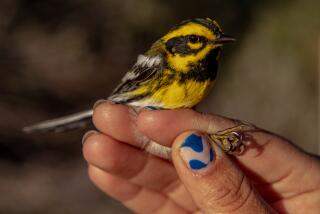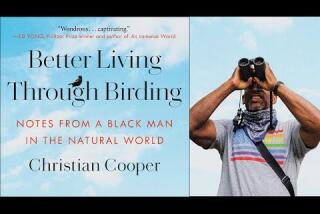Century-Old British Royal Society Strictly for the Birds--and Proud of It
- Share via
LONDON — In a country where lovers of birds abound and sometimes travel all day to glimpse a rare one, the 100th birthday of the Royal Society for the Protection of Birds is hardly a ho-hum affair.
Witness the prime minister, Margaret Thatcher. She took time off this month to christen a new locomotive The Avocet, after the wading bird that is the Royal Society’s symbol, inaugurating an array of events centered on the Feb. 17 anniversary.
Victorian gentlewomen founded the society in 1889 to combat the trade in bird feathers. It now claims to be Europe’s largest voluntary wildlife conservation group and second in the world only to the U.S. National Audubon Society.
A century ago, the slaughter of egrets to provide white plumes for hats threatened the bird with annihilation.
“The trade was eventually stopped, thanks to those women and their pledge not to wear bird feathers,” said Chris Harbard, spokesman for the society. “Killing birds for plumage is now totally outlawed in this country.”
Trade in Feathers
“It was quite a feat,” he said, because London was the center of a $10-million annual fashion trade in the feathers of such birds as egrets, kingfishers, swallows, owls and birds of paradise from New Guinea.
Royal sponsorship was bestowed in 1904. The society now has about 450,000 adult members and 110,000 juniors, employs nearly 500 people, runs 114 nature reserves and handles the equivalent of nearly $25 million a year in subscriptions, donations and legacies.
Why so much interest? “Because you can watch birds wherever you are, even in the middle of London, and not just pigeons and sparrows,” Harbard said. “You can see kestrels hunting in the City (financial district) and great crested grebes catching fish on the River Thames.”
Grebes, prized for the gingery feathers around their faces, were down to their last 42 pairs in the early 1900s. Harbard said they now number about 5,000 pairs because of conservation measures.
Britain has about 470 of the world’s 9,000 bird species. Itsmost common is the blackbird, about 15 million, and the rarest is the black redstart, of which only 50 pairs remain. The black redstart likes to breed at nuclear power stations.
Bird protection in Britain is centuries old but was introduced to save wildfowl for royal hunters. A 1533 law protected their eggs and enforced seasonal restrictions on killing the birds.
Among the society’s first campaigns was a protest of trapping songbirds and of poletraps, which fetter the feet of birds as they land on posts, leaving them to starve.
From its headquarters in an old manor house in a woodland at Sandy, 44 miles north of London, the society now runs such projects as training wardens in Ghana and Nigeria to protect birds that migrate from Britain in winter.
It works against the shooting or trapping of migrants like nightingales, warblers, blackcaps and honey buzzards as they fly south over France, Greece, Italy, Spain, Cyprus and Malta.
“It’s an uphill battle,” Harbard said. “Conservation is a concept barely understood in some countries. The bird protection society in Italy has had its offices bombed.”
He said the biggest problems are pollution and habitat loss as land is developed, so the society sometimes buys land to save birds.
In 1959 it established the Loch Garten Nature Reserve to protect the first pair of ospreys to breed in Britain for 50 years. More than a million visitors have watched ospreys through binoculars as they snatch fish on the Scottish loch and tend their young.
The white-tailed eagle, extinct in Britain since 1916, was reintroduced by the society from Norway four years ago.
Advice from the society on looking after birds includes a celebrated recipe for “bird cake” of nuts, grated cheese, seeds and household scraps. Combine one pound of the mixture with half a pound of melted lard or suet, leave it to set, then put it in a feeder.
More than 1,000 events are planned for the centenary: bird watchings, boat trips to remote nesting sites, films, exhibitions, concerts and children’s studies.
Harbard says the society gets 15,000 calls a year, often to save birds soaked in oil spills.
“We had one from a lady on the south coast who said she had an oiled bird,” he said. “We told her how to clean the oil off and then asked her what kind of sea bird it was.”
She said it wasn’t a sea bird. Her parakeet had fallen into the frying pan.
More to Read
Sign up for The Wild
We’ll help you find the best places to hike, bike and run, as well as the perfect silent spots for meditation and yoga.
You may occasionally receive promotional content from the Los Angeles Times.






